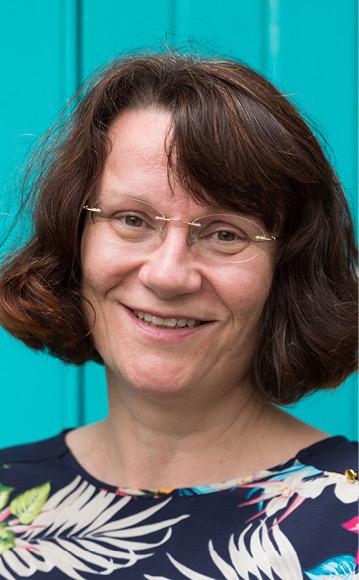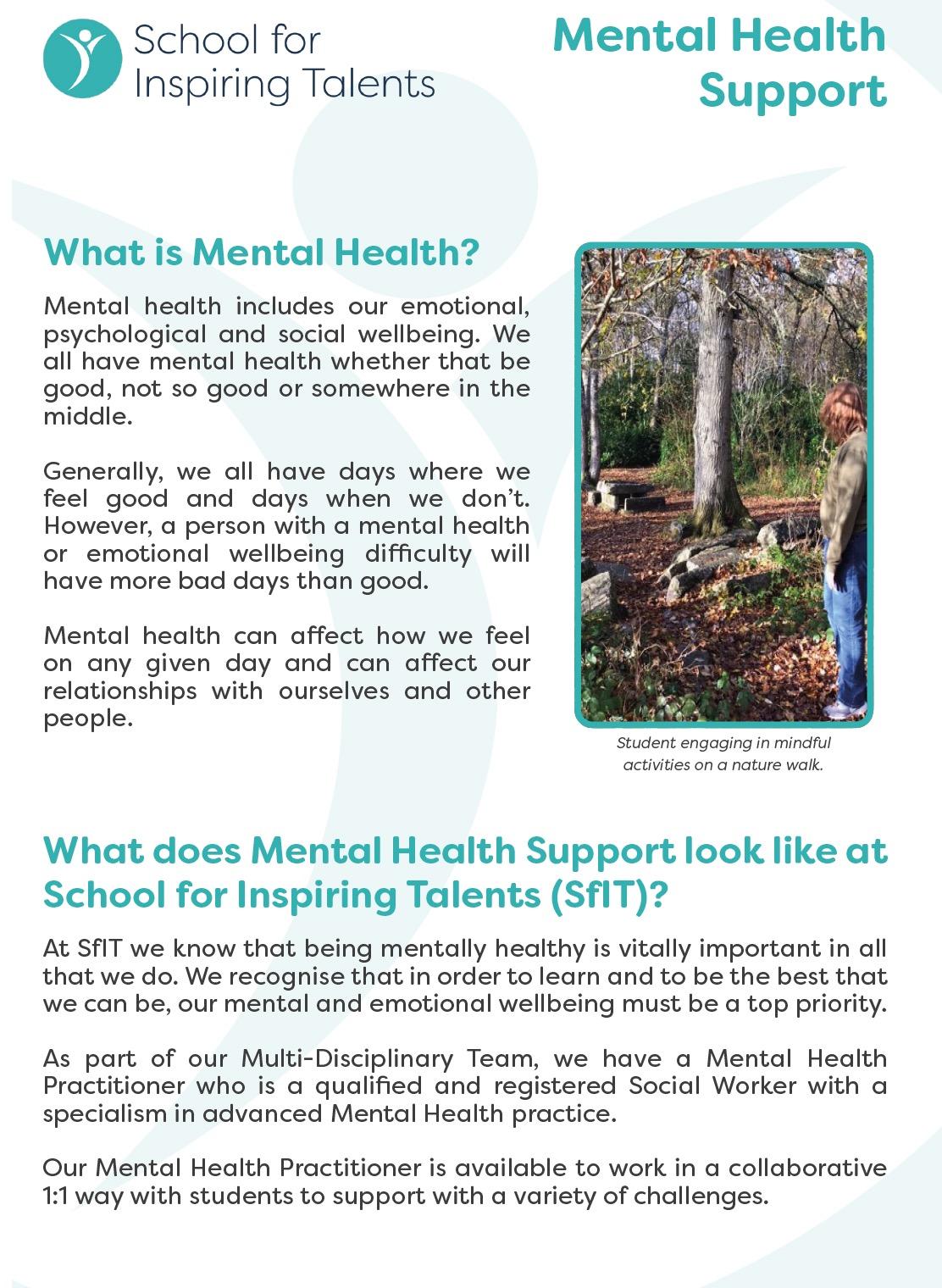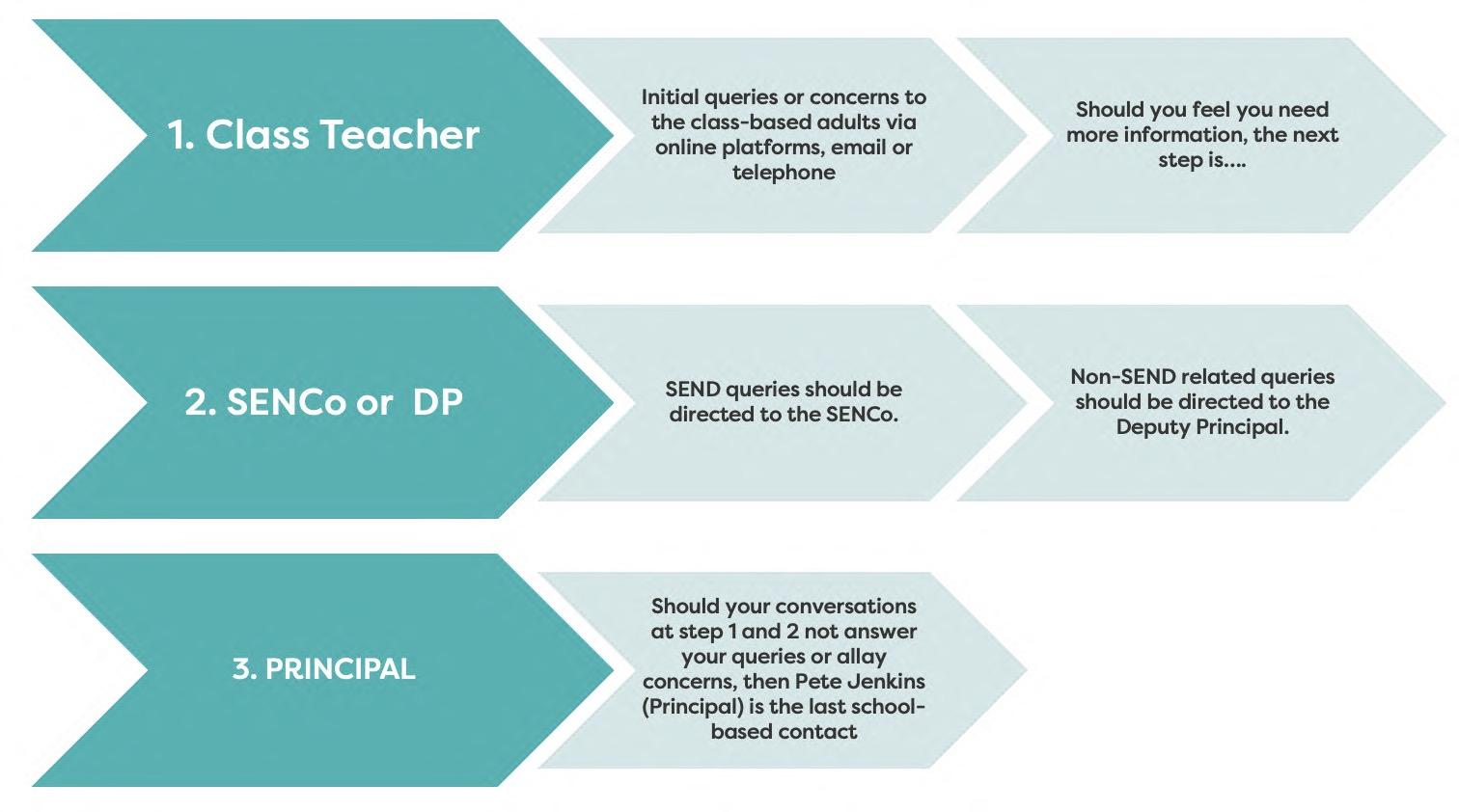School Information Report











recognize the talents of each to support them to achieve
input that parents and carers child’s education and promote provide the best possible child.
time, children may need to enable them to access
This information aims to types of support available your child; helping you to available to help and how


1. Who is the person responsible for SEND and how do I contact them?
2. What are the skills of staff who support my child?
3. How does the school identify if my child has additional SEND needs and how will they let me know?
4. What are the different types of support available for our children and families?
5. How will the school monitor the progress of my child?
6. How does the school support my child as they move between classes and schools?
7. If I have a query or concern about the provision available for my child, how can I share it and with whom?


Everyone at SfIT has responsibility for SEND but to make life easier some people co-ordinate the support that our families receive.
Curriculum Lead










p.jenkins@sfit.org.uk

l.harben@sfit.org.uk
e.hanbury@sfit.org.uk
Lewis Harben Deputy Principal Pete Jenkins Principal
All our staff receive regular training to enable them to support our children’s needs fully.

On the right are examples of SEND training over the past academic year.
Trauma
Informed practice
In addition, we have staff who deliver more specialist support to those children who require it.
Precision Training
They also provide guidance for wider staff to ensure the correct adjustments are made throughout the day.
Working within the graduated response
Safety
Intervention Training




 Emma Bushell
SEND Coordinator & Healing Together
Practitioner
Cara Porter
Speech and Language
Therapist
Janelle Penfold
Occupational Therapist
Clare HepworthWain
Emma Bushell
SEND Coordinator & Healing Together
Practitioner
Cara Porter
Speech and Language
Therapist
Janelle Penfold
Occupational Therapist
Clare HepworthWain



We know that looking after a child with additional needs can bring with it unique challenges.

Therefore, in addition to our therapeutic and SEND Team, our families have access to our Family Support Practitioner, Fay Hooper.

We have info leaflets available for our students and for parents & carers, which explain the therapeutic services offered by our team in more detail.









3. How does the school identify if my child has additional SEND needs and how will they let me know?
In-house assessments and access to external agencies


All children who attend SfIT have a recognised Special Educational Need / Disability and have been issued with an EHCP that sets out these needs.
However, over time, these needs may change and/or other needs may become apparent.
We work with parent/carers to ensure that any concerns are shared and make efforts to assess and support further needs as quickly as possible.
Initial concern arises from home or school
Progress is monitored and shared with parent/carer.
or very
Home and/or school liaise with SENCo or relevant member of MDT
MDT advice and guidance given for further adjustments and/or targeted support.
No or very slow progress despite adjustments and targeted support
Class teacher makes request for involvement for specialist support in discussion with parent/carer.
MDT or external agency engaged to provide specialist assessment and/or support
4.
are the different types of support available for our children and families?
Employing a graduated response.

As a specialist setting, most of our young peoples’ needs can be met by quality first teaching in an appropriate environment. Our small class sizes and high ratio of adults is employed to support coregulation and curriculum access and ensure that our pupils make good social, emotional and academic progress.

In addition, some pupils with more complex needs have access to further, targeted and specialist support
Additional creative sessions including Forest School
Speech, language and communication sessions.
Bespoke literacy and numeracy sessions
Individualised therapeutic sessions
Off-site alternative provision (where a bespoke curriculum is required)
Assessing, monitoring, recording and reporting

• Progress and attainment of all pupils is reviewed on a daily basis by class-based staff and adaptions are made to meet individual needs. These are shared with parents / carers via Class Dojo/ SeeSaw.
• The MDT meet formally with staff 3 times a year to discuss intervention and progress against EHCP targets so that individualised programs can be altered if required.
• In addition, the Senior Leadership Team monitor the academic progress of all children within pupil progress meetings at least 3 times a year.
• Progress and attainment are formally reported to parents three times a year though teacher reports and the annual review process.
• If there are any concerns with regard to progress, parents / carers will be informed and invited to be part of more regular ‘keeping in touch’ meetings.


One of the measures we use is the Good Childhood Index – an index of subjective wellbeing for children (suggested reading age of 8+).
It was developed to be statistically robust and covers the main aspects of children’s lives, including those identified by children themselves.
It consists of five questions regarding life satisfaction and 10 ‘single item’ questions, such as ‘How happy are you with your relationships with your friends?
Using this each year enables us to track how our students perceive their own situations and the world around them.
For example, year on year, we can see that:
Life Satisfaction increased by 5.09% across the whole school
Single item measures generally increased by 1.23%

We only accept new students who have an Education Health and Care Plan (EHCP) with Social, Emotional, and Mental Health (SEMH) as their primary need.
We accept students at any point in the school year.
Parents / carers are very welcome to make enquiries and talk to staff about our school and our therapeutic ethos, BUT please note that all referrals must come from the student’s Local Authority (LA).
Over the next few pages, you can view a detailed step - by - step breakdown of the referral process!






SfIT receives a referral from a Local Authority:
The consultation paperwork is uploaded to our administrative system. Our SfIT SEN Caseworker is the main point of contact.
The referral is discussed at our weekly SfIT consultations meeting: staff read the consultation paperwork beforehand, and at the meeting they discuss the unique needs of each individual student. Staff consider whether SfIT can meet the student’s needs and if SfIT is the right environment for the student.
If we CANNOT meet need, our SfIT SEN Caseworker will notify the LA of the outcome of the referral.
If SfIT cannot meet the student’s needs and /or is not the right environment for the student, the SEN Caseworker will formally respond to the LA detailing why SfIT is unsuitable for the age, ability, aptitude or special educational needs of the student OR why the attendance of the student would be incompatible with the provision of efficient education for students already on roll.
If there is a possibility we CAN meet need, a consultation process is started:
• The SfIT SEN Caseworker will notify the LA.
• At this point the SEN Caseworker may also liaise with e.g. Social Care, Early Help, the Virtual School, to seek additional information. This process can include attending meetings.






Our Family Support Practitioner will visit parents or carers at home: to gain their perspectives and ensure they understand the nature of the provision at SfIT (small group, classroom based with most interventions & therapies embedded in the curriculum).
A member of staff may visit the student in their current setting:
a) To undertake a distanced observation
b) To meet the student
c) To meet with staff to discuss the student’s needs.
All information gathered from this process will be reviewed at our weekly consultations meeting.
If there is still agreement that SfIT can meet student needs AND is the right environment:
• Our SfIT SEN Caseworker will liaise with the parent/ carer to arrange a timely after school visit for them and the prospective student.

• Our SENDCo or Deputy Principal will lead on this visit and answer any questions.
• They will then offer feedback to staff during the weekly consultation meeting.




Once the success of the after-school visit is established, the SfIT SEN Caseworker liaises with the Deputy Principal and parents/carers to arrange for the student to have an independent classroom visit. The Deputy Principal may request further classroom visits at different times of day (e.g. lunch breaks) and will offer feedback during the weekly consultation meetings.
Our SEN Caseworker then builds a timeline of all the key events in the consultation process, to share with the LA as part of the formal response.
The SfIT SEN Caseworker will formally respond to the LA with:
1. A timeline detailing the consultation process.
2. A completed Assessment of Need form (which details SfIT’s offer and how it can be adapted to meet the student’s individual needs).
3. If necessary, notification to explain why SfIT is requesting the higher funding tier to meet student needs.

The SEN caseworker will also:
1. Liaise with the SfIT Finance Officer to ensure an E3 (listing the relevant funding tier) is signed and returned to the Local Authority (copying in the SEN caseworker).
2. Continue to liaise with the Local Authority until the Schedule 2 IPA (contract) is received.
3. Liaise with the SfIT Finance Officer to ensure the Schedule 2 IPA (contract) is signed and returned to the Local Authority (copying in the SEN caseworker).










As soon as the LA have agreed to fund a place for the student:
1. SfIT SENDCo will agree a transition plan (unique to each student) and share this with the parent/carer and current setting.
2. SfIT SEN Caseworker will liaise with parent/carer, any professionals involved and the current school to organise transition visits for the student.

The SEN Caseworker will request all necessary paperwork from the student’s current/previous settings.
The SENDCo will produce a SEND chronology and Individual Provision Plan to aid dissemination of all relevant information to all school staff.
The Deputy Designated Safeguarding Lead will produce a safeguarding timeline to be shared with school staff.
Within FOUR weeks of a student arriving at SfIT, our Multi-Disciplinary Team will produce a trauma profile which will be shared with the class team.
They will then host a Transition Review for parents/carers, student and school staff to establish needs are being met. A Transition Review may be repeated at the end of the first term, if appropriate.
Please note: we aim to ensure all points are actioned within statutory timescales provided by the Local Authority (although receiving incomplete information from the LA may lead to timescales being extended). HOWEVER - there may be occasions (due to the needs of the school & the student) that consultations extend over hoped-for timescales - the SEN Caseworker will contact LA about any reason for delay.

We understand the importance of endings and beginnings for children who have experienced trauma hope to ensure that the process is as seamless as possible. For this reason, the transition process will only begin once your child has had their place formally accepted.
On the right is an example of the process most students will follow however, where required, enhanced transition can be discussed.


All children have transition days when moving between classes.
For some this is sufficient to meet their needs, however others may require additional support.
Extra visit to the new classroom
On the right are examples of enhanced transition activities we offer.
Transition books










Additional time with new staff
Time to explore what will be the same / different
Touchbase sessions with new pupils
We understand the difficulties faced by traumatised children and the importance of relationships to support successful transitions.

We consider effective transitions and the impact attachment needs and trauma can have when managing change.

7. If I have a query or concern about the provision available for my child how can I share it and with whom?
Home to school communication

Should you still require further assistance then there are services outside of school that may be able to help you…


Parent services can provide you with impartial and confidential information and support about additional or special educational needs.
DIAS (Devon)
https://www.devonias.org.uk
Devon Local Offer
SENDIASS (Torbay)
SENDIASS Torbay - Torbay Council
https://www.devon.gov.uk/e ducation-and-families/sendlocal-offer/
Parent (Plymouth)Partnership

Plymouth Parent Partnership | singleparents.org.uk
Plymouth Local Offer
SEND Local Offer - Plymouth Online Directory
Torbay Local Offer
Local offer - Torbay Council
